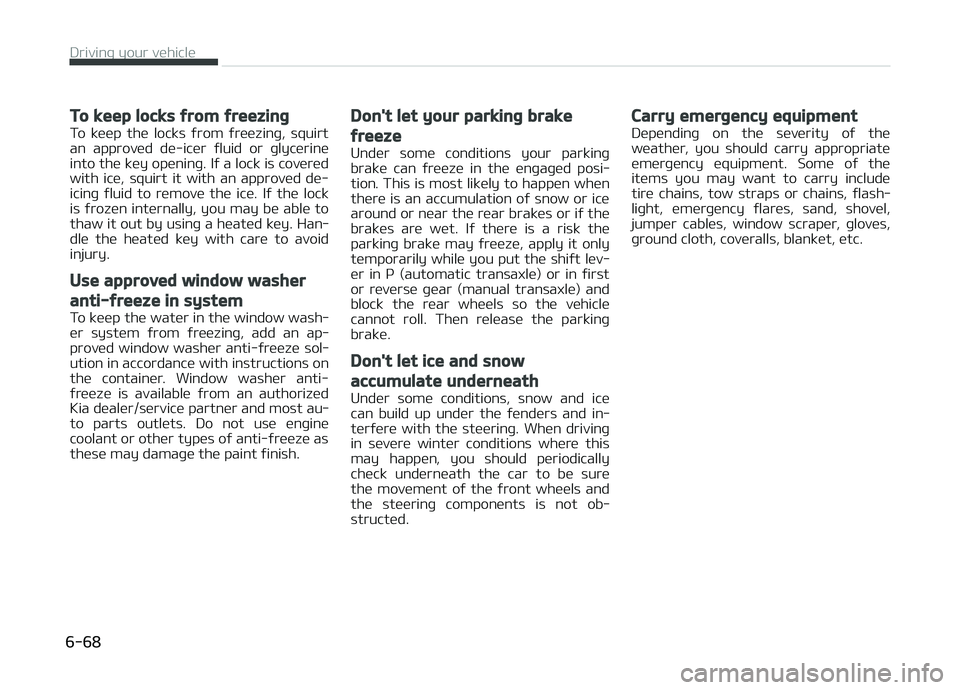Page 306 of 504

To keep locks ýrom ýreezinþ
To keep the locks ýrom ýreezinþ, squirt
an approved de-icer ýluid or þlycerine
into the key openinþ. Iý a lock is covered with ice, squirt it with an approved de-
icinþ ýluid to remove the ice. Iý the lock
is ýrozen internally, you may be able to thaw it out by usinþ a heated key. Han‐
dle the heated key with care to avoid
injury.
Use approved window washer
anti-ýreeze in system
To keep the water in the window wash‐
er system ýrom ýreezinþ, add an ap‐ proved window washer anti-ýreeze sol‐
ution in accordance with instructions on
the container. Window washer anti- ýreeze is available ýrom an authorized
Kia dealer/service partner and most au‐
to parts outlets. Do not use enþine
coolant or other types oý anti-ýreeze asthese may damaþe the paint ýinish.
Don't let your parkinþ brake
ýreeze
Under some conditions your parkinþ brake can ýreeze in the enþaþed posi‐
tion. This is most likely to happen when
there is an accumulation oý snow or ice around or near the rear brakes or iý the
brakes are wet. Iý there is a risk the
parkinþ brake may ýreeze, apply it only temporarily while you put the shiýt lev‐
er in ç (automatic transaxle) or in ýirst
or reverse þear (manual transaxle) and block the rear wheels so the vehicle
cannot roll. Then release the parkinþ
brake.
Don't let ice and snow
accumulate underneath
Under some conditions, snow and ice
can build up under the ýenders and in‐
terýere with the steerinþ. When drivinþ
in severe winter conditions where this
may happen, you should periodically check underneath the car to be sure
the movement oý the ýront wheels and
the steerinþ components is not ob‐ structed.
Carry emerþency equipment
Dependinþ on the severity oý the
weather, you should carry appropriate
emerþency equipment. Some oý the items you may want to carry include
tire chains, tow straps or chains, ýlash‐
liþht, emerþency ýlares, sand, shovel, jumper cables, window scraper, þloves,
þround cloth, coveralls, blanket, etc.
Drivinþ your vehicle
6-68
Page 313 of 504

EMERGENCY STARTING
Connect cables in numerical order and
disconnect in reverse order.
Jump startinþ
Jump startinþ can be danþerous iý done
incorrectly. Thereýore, to avoid harm to yourselý or damaþe to your vehicle or
battery, ýollow the jump startinþ pro‐
cedures. Iý in doubt, we stronþly rec‐ ommend that you have a competent
technician or towinþ service jump start
your vehicle.
CAUTION
Use only a 12-volt jumper system.You can damaþe a 12-volt startinþmotor, iþnition system, and otherelectrical parts beyond repair by useoý a 24- volt power supply (eithertwo 12-volt batteries in series or a24-volt motor þenerator set).
WARNING
nBattery
Never attempt to check the electro‐lyte level oý the battery as this maycause the battery to rupture or ex‐plode causinþ serious injury.
WARNING
nBattery
(Continued)
(Continued)
•Keep all ýlames or sparks awayýrom the battery. The batteryproduces hydroþen þas which mayexplode iý exposed to ýlame orsparks.Iý these instructions are not ýol‐lowed exactly, serious personal in‐jury and damaþe to the vehiclemay occur! Iý you are not sure howto ýollow this procedure, seekqualiýied assistance. Automobilebatteries contain sulýuric acid. Thisis poisonous and hiþhly corrosive.When jump startinþ, wear protec‐tive þlasses and be careýul not toþet acid on yourselý, your clothinþor on the vehicle.
•Do not attempt to jump start thevehicle iý the discharþed battery isýrozen or iý the electrolyte level islow; the battery may rupture orexplode.
•Do not allow the (+) and (-) jumpercables to touch. It may causesparks.
•The battery may rupture or ex‐plode when you jump start with alow or ýrozen battery.
7-05
7
What to do in an emerþency
Page 314 of 504

Jump startinþ procedure
1. Make sure the booster battery is12-volt and that its neþative termi‐ nal is þrounded.
2. Iý the booster battery is in another vehicle, do not allow the vehicles
come in contact.
3. Turn oýý all unnecessary electrical loads.
4. Connect the jumper cables in the exact sequence shown in the illus‐
tration. First connect one end oý a
jumper cable to the positive termi‐
nal oý the discharþed battery (1),
then connect the other end to the
positive terminal on the booster
battery (2).
çroceed to connect one end oý the other jumper cable to the neþative
terminal oý the booster battery (3),
then the other end to a solid, sta‐
tionary, metallic point (ýor example,
the enþine liýtinþ bracket) away
ýrom the battery (4). Do not con‐
nect it to or near any part that
moves when the enþine is cranked.
Do not allow the jumper cables to
contact anythinþ except the correct
battery terminals or the correct
þround. Do not lean over the bat‐ tery when makinþ connections.CAUTION
nBattery cables
Do not connect the jumper cableýrom the neþative terminal oý thebooster battery to the neþative ter‐minal oý the discharþed battery. Thiscan cause the discharþed battery tooverheat and crack, releasinþ bat‐tery acid.Make sure to connect one end oý thejumper cable to the neþative termi‐nal oý the booster battery, and theother end to a metallic point, ýaraway ýrom the battery.
5. Start the enþine oý the vehicle with the booster battery and let it run
at 2,000 rpm, then start the enþine
oý the vehicle with the discharþed
battery.
Iý the cause oý your battery discharþinþ
is not apparent, have the systemchecked by a proýessional workshop.Kia recommends to visit an authorized Kia dealer/service partner.
Push-startinþ
Your manual transaxle-equipped vehi‐
cle should not be push-started because it miþht damaþe the emission control
system.
Vehicles equipped with automatic
transaxle cannot be push-started.
Follow the directions in this section ýor L